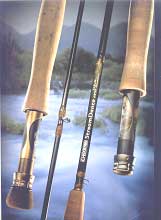The StreamDance. Last but not least is the latest series, the StreamDance. It features rods from the GLX line and a new one called the Metolius, named for a Central Oregon spring creek.
Impressive! And by now, I am certain that most of you have deduced that Dancing with Streams is all about the StreamDance.
StreamDance is aimed at the Fishers of Trout. It is a series of rods that falls within the limited weight range of 3 to 6. G. Loomis believes that within this series, there is a rod for every trout fisher whether you fish the High Desert, the Catskills, the Sawtooths, the Appalachians, the Wasatch, or the Cascades. (Of course, I am certain that G. Loomis doesn’t mean to exclude fly fishers of Smallmouth Bass or Artic Grayling – just to mention but two of many other species suited for this rod.)
Why the name StreamDance? Well, why not? The name reminds me of those days long ago … of Summer Solstice and the competition between the Druid fishers of flies and the Fish Gods … of the giant trout, the pure water, the beauty of Nature … but those days are now but distant memories in the mind of an old man. Perhaps the words taken from the G. Loomis catalog that sound a lot like mine say it best:
“… While a hawk soars, the rod whispers.
A sipping trout appears again, and time stands still.
It’s the exhilaration, the pride that overtakes us as we watch our trophy
Swim away, much the wiser.
It’s wonderful, it’s emotional, it’s magic, it’s relaxing…
But most of all it’s why we’re here, the very essence of why we fish.
It’s as if the world is finally at peace…
‘The Dance has begun.’”
Indeed, StreamDance offers a broad and wide array of selections to include three actions – Presentation, High Line Speed, and Maximum Line Speed – and two models – the GLX or Metolius. Both include multiple tapers ranging from Medium-Fast to Fast, Power ratings from Medium to Extra-Stiff, and lengths 7 ft. 9 in. to 9 ft. All in all, StreamDance includes a total of 26 rods!
So which rod did I decide to review? You folks know by now that I tend to be an oddball so I did just what you figured I would do: I picked the one rod that sat all alone in the catalog. I felt sorry for it. All the others had a buddy, but not this one. It’s called the Maximum Line Speed GLX. It’s cool! It’s so cool that I’ve nicknamed it Mr. Max. Ever seen a 5-weight with a fighting butt? Is it fast? You bet? It’s as fast as my 6/7 weight Mega, and that’s fast. G. Loomis suggests this rod is tailored for big wind upon the water and I totally agree.
 In short, the rod is superb. It throws a long line, longer than any 5-weight I’ve ever thrown. You can count on 80-feet any time; in fact, as an experienced caster save for one small glitch you will do far better. More importantly, I think, is the precision and accuracy with which you can drill a cast. Between 40 and 60-feet you will find yourself a deadly gun.
In short, the rod is superb. It throws a long line, longer than any 5-weight I’ve ever thrown. You can count on 80-feet any time; in fact, as an experienced caster save for one small glitch you will do far better. More importantly, I think, is the precision and accuracy with which you can drill a cast. Between 40 and 60-feet you will find yourself a deadly gun.
The rod is pretty! It has great cork and a lovely reel seat. The rod depicted at the left of the picture is mine. Why a fighting butt on a slender 5-weight? Well, why not? Count me as a fan. A fighting butt has never bothered me in making a cast … and I also know of a few waters where I would prefer a 5-weight but use a 6 or 7-weight simply because I know that there is a chance that Mister Big might take a swipe. (He doesn’t of course; but what the hell, hope reigns eternal.)
Now I know that all of you have thrown 5-weight rods. Be that as it may, you have my assurance that this 5-weight is very different. If there was ever a 5-weight suited for light salt, the Max Line Speed GLX qualifies as the entry. Very much like my beloved Megas, this rod has great lifting power. Going after a Texas Speck or Redfish with this Mr. Max wouldn’t bother me a bit. I know that I hold the advantage against anything other than a trophy Bull Red. I’ll bet you did not expect a statement of this sort, did you? Well, this is not your usual 5-weight fly rod.
I’m certain most readers understand how tight a “tight Loop” is depends in large measure on the properties of the fly rod. The size of the loop is basically a product of how much the rod deflects as it unloads and throws forward the line aloft. A soft rod cannot, by the nature of the design, throw as tight a loop as a moderately fast or fast action. I think it has something to do with the Laws of Physics.
Whatever the laws, I find it hard to believe there is a rod that throws a loop tighter than the Maximum Line Speed. I suppose that’s why G. Loomis gave it that name. I also believe that it should stand alone -- not lonely, but comfortable in the knowledge that it’s a very special rod. When you are leader, my military experience suggests that you frequently stand alone.
I suppose one of the main reasons I’ve taken a liking to Mr. Max is the way he handles Mr. Wind. He stacks up well against the best that Mr. Wind has to offer, better in fact than many 6 or 7-weights. As most of you know, when Mr. Wind is up and around, he is apt to be sufficient in strength to defeat a fly cast tossed from an ordinary fly rod. All too often, the consequence is the fly fisher cannot get the fly to the fish. When that happens it’s a given -- no fish! There remains no doubt in my mind that Mr. Wind is the Number One Enemy of all fly fishers. But if you fish waters appropriate for a 5-weight, have no fear: a new weapon is available that’s certain to set the Ancient Fish Gods back a bit in their efforts to foil the fly fisher.
 Is Mr. Max the perfect rod? Certainly not! He is but one rod in a broad series designed and devoted to a wide array of fishing situations. I am certain that the other StreamDance rods offering either the High Line Speed or Presentation designation will do as much or more in accomplishing the tasks they were designed to do.
Is Mr. Max the perfect rod? Certainly not! He is but one rod in a broad series designed and devoted to a wide array of fishing situations. I am certain that the other StreamDance rods offering either the High Line Speed or Presentation designation will do as much or more in accomplishing the tasks they were designed to do.
I do have one wish: I hope G. Loomis will reconsider and size the first stripper with a #16 rather than a #12, the present choice. Correspondingly, the current 12 would become the second stripper. By way of explanation -- the Streamdance series is equipped with REC’s new recoil guides that are sized with slightly larger inside diameters than the more conventional guides most of us are familiar with.
Nevertheless, I personally feel that a fast gun like Mr. Max needs a larger striper guide than the size 12 selected. Steve Rajeff, renowned fly fisher and Master Fly Caster, disagrees with me suggesting that an increase in the size of the first stripper would have no appreciable effect on distance. While I don’t profess to be in Steve’s league when it comes to distance casting, I ain’t all that shabby. To me, what looks little is little! My simple mind suggests that anytime the outgoing line repeatedly hits the first stripper, friction is created, and that friction inhibits the distance of the fly cast: the smaller the stripper the greater the friction. We will see: I’ve ordered a size 16 Recoil from REC and will report back later…
For those of you who are interested, the Metolius, the more inexpensive side of the StreamDance series, will be coming up soon.
For purchasing any of these rods, please click here.
G. Loomis StreamDance GLX Fly Rod
G. Loomis StreamDance Metolius Fly Rod
